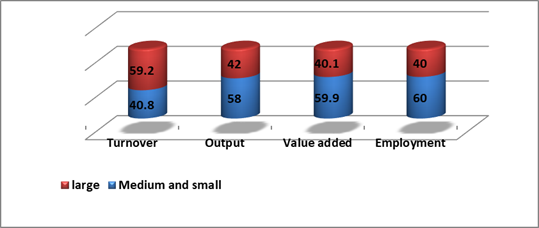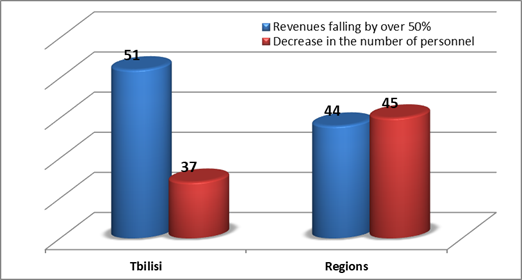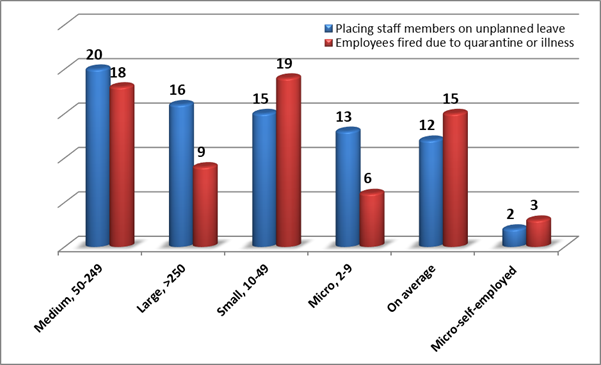
The international scientific and analytical, reviewed, printing and electronic journal of Paata Gugushvili Institute of Economics of Ivane Javakhishvili Tbilisi State University

THE IMPACT OF COVID-19 ON THE ACTIVITIES OF SMALL AND MEDIUM-SIZED ENTERPRISES IN GEORGIA
10.36172/EKONOMISTI.2021.XVII.02.Kurdgelia
Abstract. The article considers the role of small and medium businesses in Georgia’s economy, and comparisons are made with different countries. The main part of the article is devoted to the impact of the COVID-19 pandemic on small and medium-sized businesses, the challenges posed by the pandemic and the role and importance of state aid programs for entrepreneurs.
Key words: pandemic; coronomics; small and medium-sized businesses; financial liability.
In the current context, small and medium enterprises play an important economic and social role. They are even called the backbone of the country's economy.
The process of establishing a small business in Georgia has coincided with very difficult economic, political or social conditions, which were characterized by a number of special features. If the development of the market economy in developed countries started mostly with the establishment of small enterprises and then, based on their evolution and competitive struggle, large structures were gradually formed, in Georgia, in fact, the opposite process played an important role in the formation of business establishments. In the 1990s, the break-up of the existing large enterprises into small ones took on a mass character, simplifying and reducing the corresponding technological processes. The Law "On Measures for the Development and Promotion of Small Entrepreneurial Activities in the Republic of Georgia" adopted in 1999 was intended to bring within the legal framework the relevant business environment and development conditions and to establish order in the chaotic development of enterprises of this size. [Chikhladze, 2009]
In developed countries, small and medium-sized businesses, in addition to the economic function, assume also an important social function - it is the basis for the emergence of a middle class in the population, because along with ensuring stable economic development, they employ a large part of the population. Therefore, small and medium enterprises, with their employment growth and job creation potential, as well as in terms of their contribution to economic development and growth, can be considered to be the cornerstone of any country's economy.
A strong and well-developed sector of small and medium-sized enterprises significantly contributes to exports, innovations, the creation of a modern entrepreneurial culture, and at the same time, plays a special role in improving the well-being of the country. Small and medium enterprises respond flexibly and quickly to market changes, easily assimilate new products and are mostly focused on local markets. [Tokmazishvili, 2017]. Due to the relatively low capital-labor ratio, they create about 1.5-2.0 times more jobs compared to large enterprises with equal amounts of investment.
In recent years, Georgia has implemented significant economic reforms, the main goal of which was to provide an enabling environment for business and foreign direct investment, liberalization of the economy, the reduction of administrative barriers and the tax burden, improvement of public services, and struggle against corruption. As a result of these reforms, Georgia's economic policy has been positively assessed by various rating agencies and international financial institutions, and the relevant results have been reflected in the indices and ratings that measure the economic freedom of countries [Strategy 2016-2020].
Meanwhile, despite the improvement of the general business environment, Georgia faces the same challenges in terms of small and medium enterprise development as in many developing countries. Although most of the operating enterprises are the small and medium enterprises, their contribution to GDP is still very small.
In developed countries, small and medium-sized enterprises constitute the rather high percentage of the business, making up more than 50% of the total turnover of the business sector, accounting for two out of every three jobs created. In the Organization for Economic Cooperation and Development (OECD) countries, most companies are small and medium-sized enterprises and create two thirds of the gross domestic product (GDP). In developing and transition economies, small and medium-sized enterprises account for more than 90% of the total number of enterprises, although their share in GDP is generally quite low - often less than 20% [Gogiashvili, 2014].
The largest share of both the turnover and output of the business sector is occupied by large enterprises (in Georgia in 2020: turnover - 59.2%, output - 42.0%), however, due to more dynamic and rapid development of small and medium-sized businesses, the share of large business during the pandemic was gradually declined. Such businesses accounted for more than 4/5 of the total increase, while the growth rate of output by small and medium-sized businesses was many times higher than the growth rate of output by large businesses.
Diagram 1
Structure of business turnover, output, value added and employment by business sizes in Georgia in 2020, %

The coronavirus pandemic has made serious adjustments to these dynamics.
In 2020, compared to the previous pre-pandemic 2019, despite that the turnover of the business sector increased nominally (by 0.5%), as well as the nominal growth was observed in large-scale production (+ 7.0%), the turnover of small and medium enterprises, as well as output decreased sharply, especially in the case of small and medium-sized productions, as the following table shows.
Table
Turnover and output of the business sector by sizes
of enterprises in 2020 (in percentage as against the previous year)
|
|
Total |
Large |
Medium |
Small |
|
Turnover |
100.5 |
107.3 |
90.0 |
93.7 |
|
Output |
91.5 |
92.5 |
91.8 |
90.1 |
Small and medium business activities are carried out in a certain environment, which ensures its civilized successful development or its stifling. The global COVID 19 pandemic has done tremendous damage to the economy of Georgia as well as to the global economy, especially to the sector most sensitive to its risks, such as small and medium-sized businesses, including employment as well. The number of employed in small business in 2020 decreased by 28.8 percent compared to the previous year, which is two times more than the rate of decrease in the total number of employed persons in the business sector (-14.0%). In 2020, 92 percent of the reduction in the total number of employed in the business sector was from the reduction in the number of employed in small enterprises.
The pandemic has led to the emergence of two closely related areas focusing on small and medium-sized businesses: on the one hand, in terms of identifying to identify and scaling the problems that are confronting by this type of business, and, on the other hand, with a view to developing and implementing the state support measures.
The study entitled "Georgian companies facing the challenge of the COVID-19 pandemic" analyzes the impact of the pandemic on the Georgian business sector, of which small and medium-sized businesses stand out as our priority. We were faced with the fact that small and medium-sized enterprises were forced to layoff part of their employees or reduce their salaries, and another part of them temporarily suspended their activities because of a two-month state of emergency declared to prevent the the coronavirus from spreading, which included curfew and movement restrictions, which in turn has significantly affected small and medium-sized businesses.
Research reveals that declining demand is the most pronounced side effect caused by the COVID-19 pandemic. The lower demand in most of the surveyed enterprises (65%) has already led to revenue declines by over 50%. Hotels and restaurants were the worst affected, 75% of which encountered significant revenue declines. Only 1% of companies in this field were able to maintain pre-crisis revenue levels, while the share of such companies in the information technology and communications sector reached 10%, and in the agricultural sector - 17% (an average of the national economy - 5%). About half of the companies surveyed expect revenue to fall by more than 50% compared to the previous period. Even in this case, the most negative prognosis is evident in the hotel and restaurant business. 71% of companies surveyed have adverse expectations in this regard, while only 40% of companies engaged in the information technology and communications sector and only 28% of representatives of the agricultural sector have the same expectations [Williams et al., 2020].
Declining demand, the overdue payments from customers, and change in the behavior of consumers in general have created the companies’ liquidity problem. 28% of the surveyed companies have already faced problems in implementation of their existing commitments, about half of them will face these challenges in 1-6 months, while only 15% of the companies surveyed plan to maintain liquidity without reductions. In order to respond declining demand and liquidity problems in a timely manner, the companies had to reduce the number of employees in a timely manner. More than 50% of the surveyed enterprises have already reduced the number of employees on various scales. Among them, the biggest reductions are observed in the hotel and restaurant business - more than 40% of companies in this sector laid off the staff.
In this respect, the agricultural sector was less seriously affected. Due to the uncertainty surrounding the future development of the pandemic, business expectations also coincide with the assessment of the current situation. With the spread of the pandemic, most companies have faced the challenge of seeking additional funding. 79% of the surveyed enterprises need additional funding, but 85% of surveyed companies have not yet applied to financial institutions for funding. And from the segment that has already applied to financial institutions, a large part has denied funding. Exceptions in this segment are large companies, of which 42% have received funding, 36% are waiting for a response from the bank, and only 22% have denied funding [Williams et al., 2020].
It should be noted that in terms of economic situation, the expectation of a negative scenario is higher in Tbilisi, and in terms of reduction in the number of employees - in the regions, as shown in the diagram below.
Diagram 2
The level of adverse expectations revenues and employment
dynamics in Tbilisi and regions, %

If we consider the difficulties of companies caused by the pandemic only in terms of employment - we will notice that their burden was felt relatively much among the medium-sized enterprises (50-249 employees) (see Figure 3).
Diagram 3
Impact of complications caused by the COVID-19 pandemic on employment,
by sizes of companies, %

The decline in demand/revenue due to the economic crisis caused by the pandemic in the business sector is associated with the following five main circumstances:
1. Quaranete measures - Companies whose business relies on direct sales to customers have significantly reduced revenue due to the closure of their businesses during the quarantine period.
2. Closed borders and reduced number of tourists - mainly affected hotels, restaurants and cafes (HORECA) and their suppliers (food and beverage manufacturers and suppliers), and the construction sector (reduced housing and retail sales to foreigners, new hotel construction). Although international tourism has been partially replaced by national tourism, the amount of expenditure incurred by local tourists is significantly lower compared to foreign visitors.
3. Delayed arrival of revenues - The situation was problematic in both the HORECA sector and small retailers sector.
4. Change in the behavior of customers - Local consumers have switched to relatively cheaper products and increased their spending on basic necessities (e.g., food and less money on luxury items or long-term investments).
5. The tense situation in wxport markets - The pandemic has had a significant impact on several sectors of foreign countries, in particular lowering purchasing power of the population in these countries, which is why many foreign customers have consequently reduced or canceled their orders.
Certain export commodities that rely on intermediary agents have experienced a significant decline. This was mainly due to exchange rate fluctuations and unpredictability. Responding measures taken by the surveyed companies were as follows: some companies focused on government orders (for example, construction or the HORECA sector) due to greater stability, and also concentrated mainly on the Tbilisi market. Most businesses, where possible, have been forced to switch to online sales. To compensate for the decline in revenue, most of the companies surveyed attracted additional financial resources or restructured their debts.
In recent years, the government has implemented numerous reforms to support small and medium-sized enterprises. One of the most successful programs is "Produce in Georgia", which turned out to be a chance for many start-up entrepreneurs to implement their business ideas. There are several organizations supporting small and medium enterprises in Georgia, including: Georgian Chamber of Commerce and Industry, Georgian Employers' Association, and Georgian Small and Medium Enterprises Association.
The "Produce in Georgia" program aims to support industrial and agricultural entrepreneurs, create new enterprises, expand existing businesses, and raise the level of competitiveness and export potential of the private sector through access to finance, real estate, and technical assistance. Two new directions have been added to the project "Produce in Georgia": a) in 2015 - promoting the development of hotels, which means financing costs of the franchise, and b) in 2016 - promoting the film industry. The main goal of "Produce Georgia" program’s micro and small entrepreneurship is to promote the growth of economic activity in the regions of Georgia and includes two components: financial and technical assistance [Program].
Many start-ups have received support from the state under the program, a good example could be the participation of Georgian companies in the Gulfood 2021 exhibition organized by the Export section of the “Produce in Georgia” Agency and with support from the USAID Agriculture Program.
Conclusion
Despite the improvement of the general business environment, Georgia faces the same challenges in terms of small and medium enterprise development similar to those of many developing countries. Although most of the operating enterprises are small and medium enterprises, their contribution to GDP is still low. The Government of Georgia attaches particular importance to small and medium enterprises in the process of economic development and aims to further improve the business environment, which will promote the growth and development of small and medium enterprises. This attitude is of particular importance in the context of the economic recession caused by the COVID19 epidemic, which, along with the country's economy, has particularly affected small and medium-sized enterprises.
Carrying out the above measures to support small and medium-sized businesses would significantly help them not only preserve the stability and sustainability during the crisis period, but they would also significantly raise the level of competitiveness of such enterprises in the domestic and foreign markets in the post-pandemic period.
References
- The business sector in Georgia. 2020. National Statistics Office of Georgia. URL:https://www.geostat.ge/media/35014/Krebuli-2020.pdf
- Gogiashvili O. (2014) – The problems of small and medium-sized businesses and ways to address them in Georgia, Kutaisi.
- Tokmazishvili M., (2017) Promoting the development of small and medium-sized enterprises (the cost rising development). The National Parliamentary Library of Georgia.
- The “Produce in Georgia” program. The program of micro- and small business promotion URL:http://www.enterprisegeorgia.gov.ge/ka/%E1%83%91%E1%83%98% E1%83%96%E1%83%9C%E1%83%94%E1%83%A1%E1%83%98%E1%83%A1-%E1%83%92%E1%83%90%E1%83%9C%E1%83%95%E1%83% 98%E1%83%97%E1%83%90%E1%83%A0%E1%83% 94%E1%83%91%E1%83%90/microgrants
- SME Development Strategy of Georgia - 2016-2020 URL: http://gov.ge/files/439_54422_706524_100-1.pdf
- Williams et al., (2020) Georgian companies in the face of the challenge of the COVID-19 pandemic. URL:https://www.pwc.com/ge/en/assets/pdf/may-2020/Georgia_Covid-19_survey_Report_Final_Georgian_21.05.20.pdf
- Chikhladze N., (2013) On the issue of identifying trends of small and medium-sized business development in Georgia. Akaki Tsereteli State University. Proceedings of the International Scientific-Practical Conference devoted to the 80th anniversary of the University’s establishment. Kutaisi.
